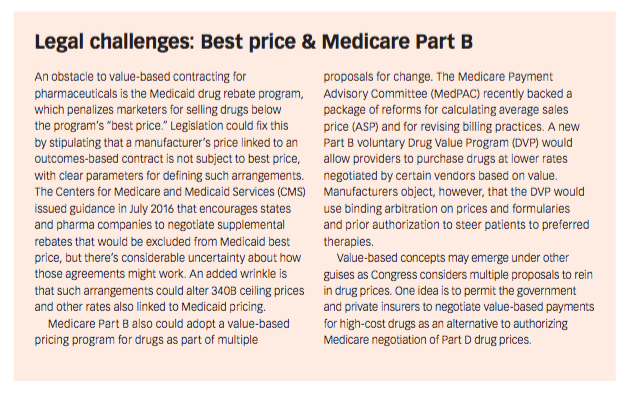Measuring the Value of Prescription Drugs
Pharmaceutical Executive
Payers and pharma companies seek outcomes data for evidence-based reimbursement deals.
One strategy for addressing the national outrage over drug pricing is to shift the discussion from “pay-per-pill” to outcomes-based pricing linked to how well a medicine improves patient health and reduces cost of treatment. Pharma companies are looking to justify prices by tapping payer data systems to document the effect of a new therapy in the real world.
Unfortunately, there’s little agreement on how to define and measure clinical outcomes, collect and analyze such data, and apportion costs and control over value framework projects. And efforts to calculate the value of gaining a year remission from cancer or greatly reducing the chance of a heart attack raise even trickier
Jill Wechsler

ethical and logistical challenges.
Analysts are responding with new systems to assess the impact of biomedical treatments on individuals and on broader patient groups, with an eye on identifying patients most likely to benefit from a certain treatment. Such targeting would support payment strategies that justify higher rates for therapies likely to improve health, and lower prices on treatments with uncertain effectiveness. A “pay-for-performance” approach may start with a manufacturer offering a highly discounted baseline price to insurers, with additional pre-set payments back to the pharma company for achieving a certain performance target. The converse is to start with a higher price, with the manufacturer paying a rebate to insurers if patient outcomes fail to achieve an agreed-on threshold.
Pilots and frameworks
Emerging consensus on methods and expanding health plan interest in providing needed data encourage such initiatives. Genentech and Priority Health ran a pilot in 2015 to test potential benefits of using Avastin to treat patients with non-small-cell lung cancer. As described in an article posted by Health Affairs on April 3, Genentech provided rebates to Priority Health linked to progression-free survival (PFS), with no payment if PFS exceeded six months.
Amgen seeks outcomes-based contracting for rheumatoid arthritis therapies with data systems managed by Inovalon’s Avalere Health, as seen in a February agreement with Harvard-Pilgrim health plan that reduces the price of Amgen’s Enbrel if patients benefit from treatment. Last year, Harvard-Pilgrim also launched a deal with Novartis that provides a discount on cardiovascular drug Entresto if patients avoid hospitalization. Another Avalere project supports outcomes-based contracting for Boehringer Ingelheim’s diabetes alliance with Eli Lilly. Avalere president Dan Mendelson notes that health plans have become more willing and able to provide meaningful measures of patient outcomes as they see benefits in value contracting.
To encourage such reimbursement strategies, the National Pharmaceutical Council (NPC) has developed a
Sidebar: Medicare challenge (click to enlarge)

set of “guiding principles” that it hopes will shape pharmaceutical value frameworks under development by medical societies and healthcare organizations. NPC, the National Health Council, Faster Cures and other stakeholders emphasize the importance of considering patient perspectives and promoting transparency in comparative and cost assessments, as well as the potential for drugs to offset treatment costs.
Manufacturers would like to see such principles adopted by the Institute for Clinical and Economic Review (ICER), the most prominent value assessment organization, which recently updated its framework to incorporate patient views more visibly in evaluating leading drugs and drug classes. NPC and others object to ICER measurement of gains in quality-adjusted life years (QALYs) and of the budgetary impact of new drugs, regarding such calculations as unrelated to the many ways a therapy can provide value to patients, payers and society. ICER isn’t changing that much, but has agreed to lower its QALY threshold to $50,000 from $100,000 and to measure net drug prices, minus rebates, when possible.
While payers are particularly interested in value assessments for widely used therapies to treat chronic conditions such as diabetes and high cholesterol, there’s also growing interest in similar calculations for costly treatments for cancer and rare diseases. ICER is holding an orphan drug assessment summit May 31, which will consider methods for evaluating the effectiveness, development costs and value of Biogen’s spinal muscular atrophy treatment Spinraza and policies affecting the Duchenne muscular dystrophy drug Exondys 51.
Prices and cures
The bottom line for all stakeholders is whether value analysis supports higher prices for effective new therapies, and justifies reduced rates on those with uncertain benefits. Prescribing has been surprisingly low, for example, for new PCSK9 cholesterol therapies, largely due to high launch prices and limited data on effectiveness. Regeneron and Sanofi worked to avoid a similar fate for their highly touted new eczema treatment, Dupixent, launched at a $37,000 list price following early consultation with payers. The sponsors are expected to seek results-based agreements with payers, with rebates offered to patients who fail to see clear benefits after a certain period of time.
New gene-based therapies able to cure blindness or hemophilia would raise difficult questions about who is responsible for covering a costly, one-time treatment with enormous benefits. European single-payer health systems can better accommodate such situations, but frequent patient shifts in insurance coverage in the US complicate the reimbursement picture. Outcomes-based analysis could demonstrate that spending $1 million

for a miracle cure is cost-effective compared to paying $100,000 a year for ongoing treatment, but such outlays may require government involvement and apply to limited patient populations. Gilead ignited a firestorm two years ago with its $84,000 initial price for the hepatitis C cure Harvoni when it failed to anticipate payer pushback due to the large number of people seeking treatment.
Analysts are studying why some value-based negotiations fail and strategies for building trust and confidence in these arrangements. Public skepticism of value calculations by pharma will dissipate only when visible savings and health improvements emerge.
Jill Wechsler is Pharmaceutical Executive’s Washington Correspondent. She can be reached at jllwechsler7@gmail.com

Trump: 'Major Tariff' on Pharmaceuticals Coming Soon
Published: April 9th 2025 | Updated: April 9th 2025“We’re going to tariff our pharmaceuticals, and once we do that, they are going to come rushing back into our country," President Donald J. Trump said during a Tuesday night dinner in Washington.